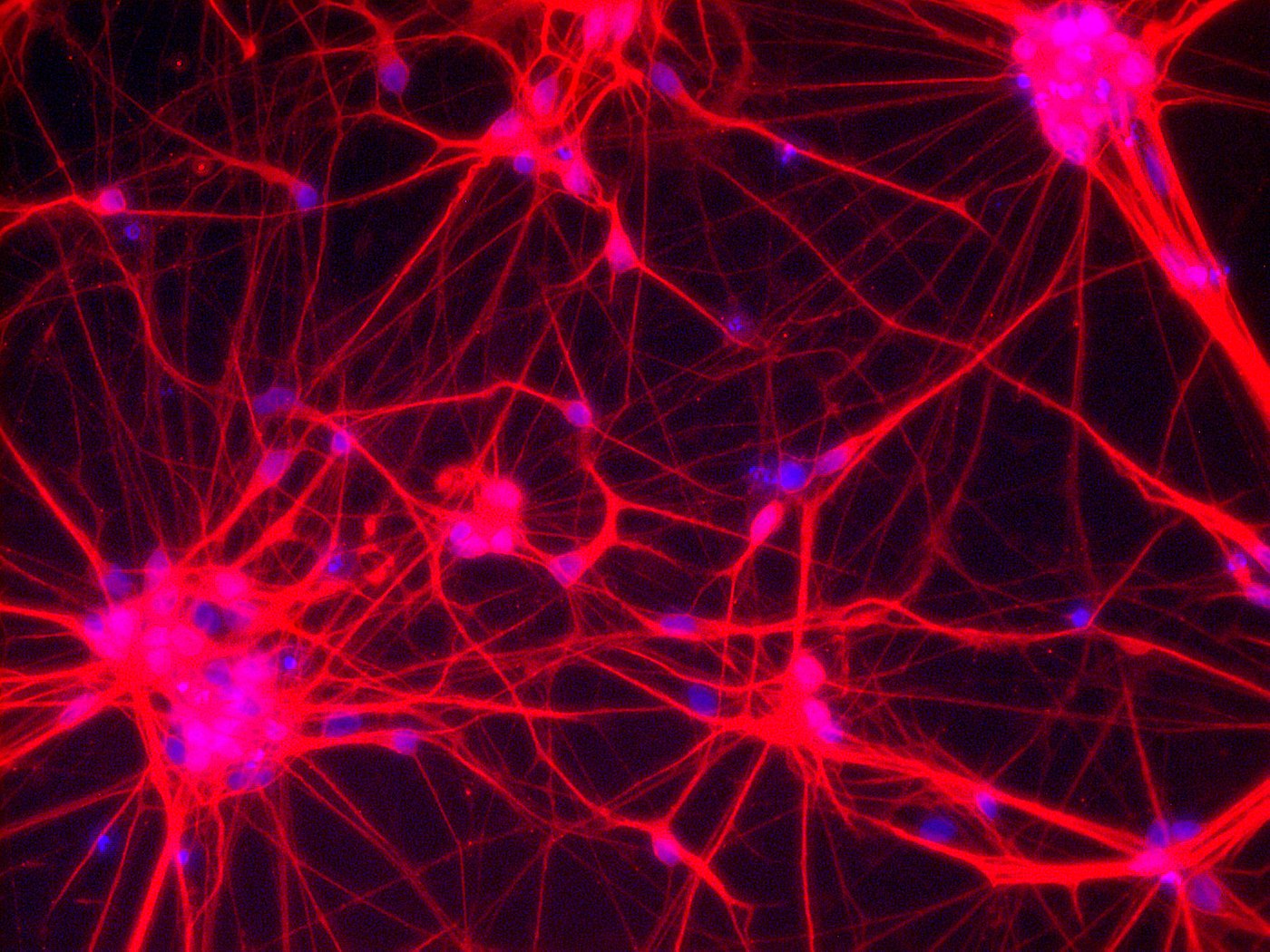
Neurons – Network of neuronal cells (Blue: nucleus; Red: neurons) [Copyright: Institute for Transfusion Medicine, UK Essen]
Translational stem cell research projects bridge the gap between fundamental research carried out in the lab and the application of this research to the field of patient care.
Who are the people behind these kinds of projects? What interests them - in their own research field, but also above and beyond that? What drives them right now?
The aim of this series is to try and make the abstract term 'translation' more tangible and to give you a glimpse behind the scenes of the world of translational stem cell research. In the third part of this series, we welcome Bernd Giebel.
I am … My name is Bernd Giebel. I am 49 years old and the father of a nine-year-old son. I was trained as a developmental biologist at the University of Cologne. I have been working with hematopoietic human stem cells since 1999, starting at the Heinrich Heine University Düsseldorf and then at the University Hospital Duisburg-Essen where I have been since November 2008. As part of our basic research in this area, I became aware of the existence of exosomes in 2005 – extracellular vesicles 70-150 nm in diameter – which are released by practically all cells, including stem cells, along with a number of other extracellular vesicles such as microvesicles. Since 2009 we have been investigating and also experimenting with these extracellular vesicles (EVs) and exploring in particular their therapeutic potential in regenerative and immunotherapies. We use mesenchymal stem/stroma cells (MSCs) as a starting material for isolating therapeutically active EVs. MSCs have already been used in a number of clinical studies for treating diverse illnesses with varying degrees of success. It seems that the therapeutic effects of MSCs are in many cases relayed by EVs and not, as has long been assumed, by the direct insertion of the MSCs into the damaged tissue. Since EVs are not able to self-replicate, can be sterilized by filtration and are easier to handle than cells, EVs exhibit a number of therapeutic advantages over cells. In 2011, using MSC-EVs, we performed an individual treatment attempt administering MSC-EVs to a patient who had developed a non-treatable graft versus host disease following a bone marrow transplant, a frequently occurring side effect of bone marrow transplants. The results, i.e. that the MSC-EV treatment led to a four-month suppression of the disease symptoms, motivated us to intensify our research in this direction. Our aim is to qualify MSC-EVs for routine clinical use. To achieve this goal, we need to optimize, validate and qualify a number of diverse steps in production and quality assurance. As the winning consortium of the Translational Stem Cell Research funding competition, we have begun to tackle this challenge and have been able to successfully implement the first steps towards achieving translation. The consortium comprises scientists from Essen University Hospital, the Dortmund-based Leibnitz Institute for Analytical Sciences e.V. (ISAS) as well the NRW-based companies Particle Metrix GmbH and PL Bioscience GmbH. Further requisite research steps will now be funded by the lead market competition organized by LifeSciences.NRW as part of the consortium project entitled Production and Quality Assurance of Stem Cell-Derived Extracellular Vesicles for Novel Regenerative and Immunomodulatory Therapeutic Approaches (SEVRIT). The consortium consists once again of scientists from Essen University Hospital and ISAS as well the two aforementioned NRW-based companies.
What importance does the Translational Stem Cell Research competition funding have for you personally and for your work in general? The approach of translational research differs considerably from that of basic research. Here the aim is not to deliver new findings, but to optimize processes in such a way that they meet the specific guidelines necessary for producing therapeutics. Besides complying with rules and regulations, it is crucial for production and for the requisite quality controls that follow that the techniques are robust and can be reproduced rigorously. Classic funding instruments do not support this kind of research adequately, as it is extremely expensive due to the high standard required. The Translational Stem Cell Research funding has allowed us to access this kind of research and thus provided us with the basis for subsequent translational projects. As a basic researcher, this funding has allowed me to strike out in a new direction - something which I wouldn’t have even dared to dream about a couple of years ago.
A scientific highlight for me right now … Now and again, there are obviously a large number of really interesting discoveries in the field of science. In recent years, I've realized the importance of the role that extracellular vesicles play in the body. The change that has occurred in my understanding of biological processes is a personal scientific highlight. It is becoming apparent that cells use EVs under both physiological and pathophysiological conditions in order to communicate with one another in very complex ways, over both short and long distances. For me, it is almost as if aliens have been wondering for years how humanity has managed to organize itself across continents and then suddenly realized that humans can communicate directly with one another across huge distances by letter, via the Internet or by phone. If we can understand this newly discovered communication system better, it will open up new options for treatments and diagnostics for a number of different diseases. In the medium to long term, it is my understanding that EVs will revolutionize various fields of basic and applied research.
What I would also like to achieve this month outside of the world of science … Christmas is nearly upon us. Alongside getting presents for loved ones, I am also going to try and visit a couple of the Christmas markets in the Rhein-Ruhr region.